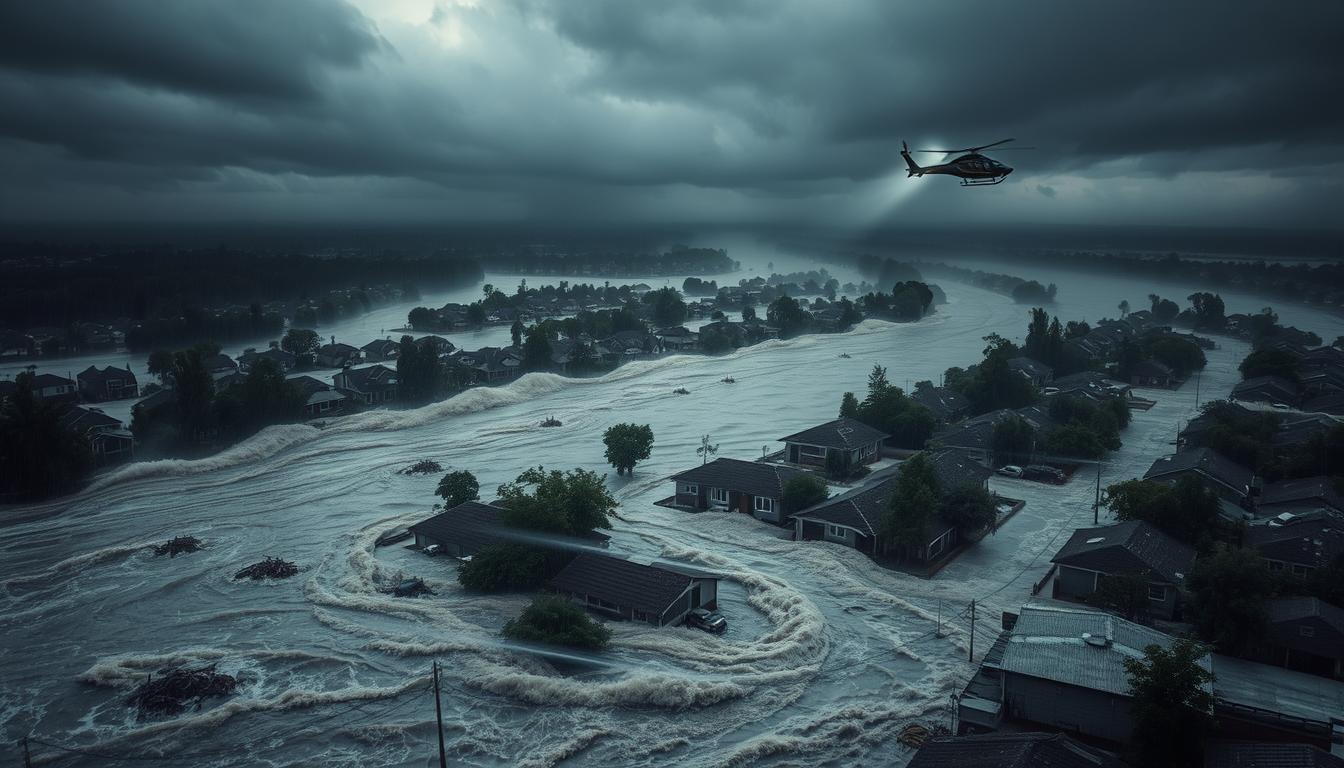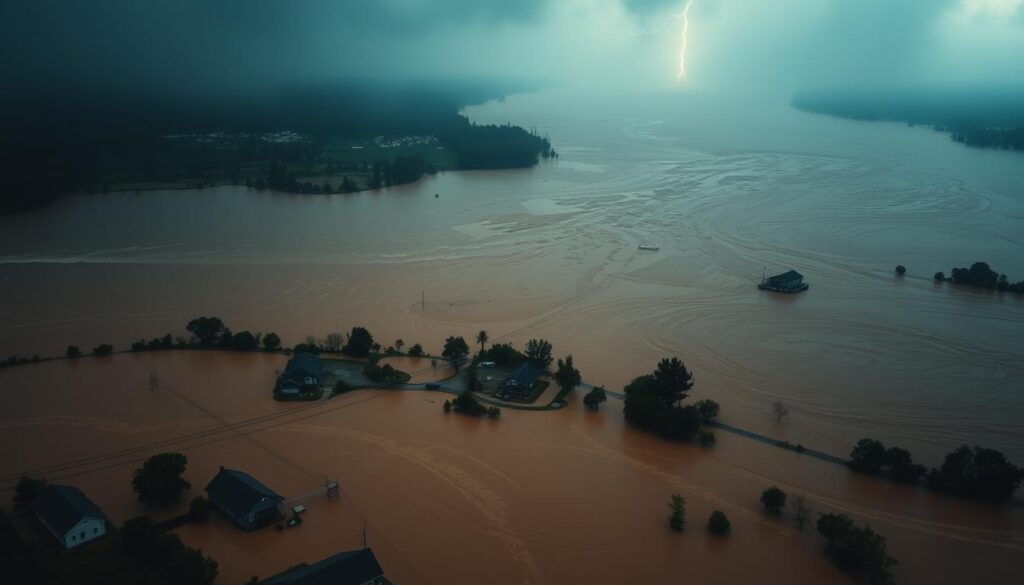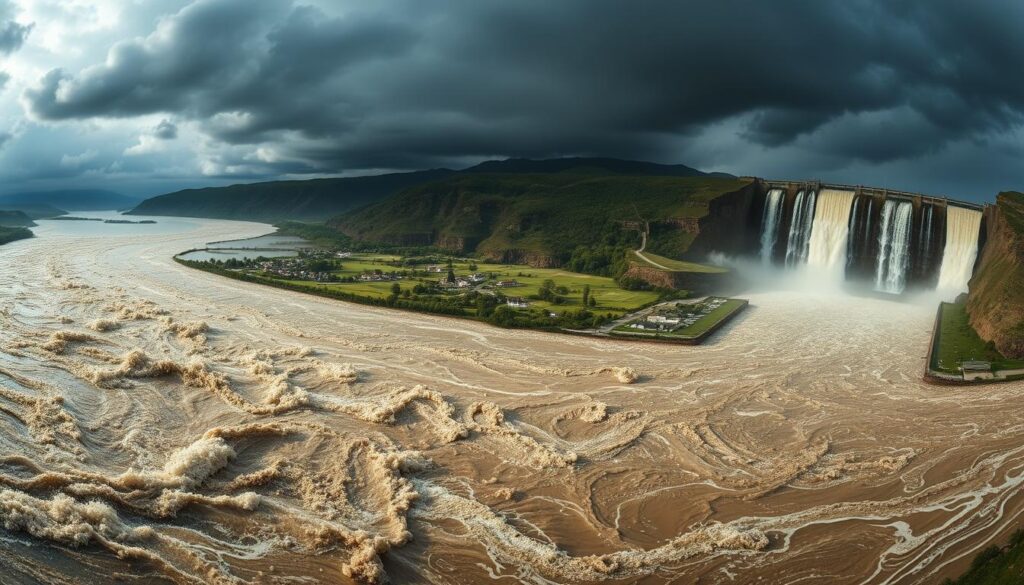Physical Address
304 North Cardinal St.
Dorchester Center, MA 02124
Physical Address
304 North Cardinal St.
Dorchester Center, MA 02124

Floods are a major natural disaster that hits millions around the world. They cause extensive damage to infrastructure, homes, and the environment. You might be surprised to learn that floods are the most common natural disaster. They account for more than 40% of all disasters globally.
It’s important to understand floods and their impact. This knowledge helps us prepare for and mitigate their effects. As you learn more about floods, you’ll find surprising facts. These highlight the need for flood awareness and preparedness.
It’s important to understand the power of floods to protect our daily lives. Floods can happen from heavy rain, storm surges, and dam failures. Almost all natural disasters can lead to flooding, so it’s key for everyone to know the dangers.

Floods can destroy homes, businesses, and important infrastructure. They also harm the environment. This can move people from their homes and stop work and business.
Knowing about floods helps you get ready for and deal with them. By understanding the risks and taking steps early, you can keep yourself and your family safe. Learning about floods is vital to avoid harm or loss during floods.
Flood awareness is more important than ever. Weather patterns are getting wilder, and cities are growing. Knowing about flood risks and how to lessen them is essential for your safety. Being ready and informed is your strongest defense against floods.
It’s key to understand the science of floods to lessen their harm on communities. Floods are complex disasters caused by heavy rain, snowmelt, and storm surges.
Floods come in various types, each with its own cause and traits. Here are some common ones:

Floods form through the hydrological cycle. Rain or snowmelt flows over land, into rivers, lakes, and oceans. If there’s too much water, flooding happens.
The hydrological process includes several important factors:
Knowing these factors helps predict and manage flood risks better.
Floods have shaped human history in many ways. They have affected ancient civilizations and modern societies alike. The world has seen the impact of floods everywhere.

The Great Mississippi Flood of 1927 was a major disaster in the U.S. It displaced over 640,000 people. This led to big changes in how we manage floods today.
The Mississippi River and Tributaries Project was created. It’s a system that protects millions from floods now.
The 1931 China Floods were the deadliest in history. Estimates say 3 to 4 million people died. Heavy rain, siltation, and dam failure caused the disaster.
This tragedy showed us how important strong dams and flood planning are.
Hurricane Katrina hit in 2005. It caused massive flooding in New Orleans because of levee failures. Over 1,800 people died, and damages reached $125 billion.
Katrina’s impact led to big investments in flood protection. It also changed how we respond to disasters.
Recent floods, like those in Houston and Venice, show flooding is a big threat. These events teach us about resilience and community readiness.
Learning from past floods gives us surprising flood information. It helps us prepare for and lessen the effects of future floods. By understanding past floods, we can find unusual facts about floods to guide our responses.
Floods are more than just damage; they have surprising facts that amaze us.
Floods are powerful natural disasters. They can greatly affect our environment and communities. Their ability to surprise us with their force and speed is fascinating.
Flash floods are very dangerous. They can move at up to 30 miles per hour. This speed can cause a lot of damage, including loss of property and life.
Floodwaters can move huge boulders, sometimes weighing several tons. This shows the incredible power of a flood.
Fast-moving water as little as six inches can knock you off your feet. This is a reminder to be careful during floods.
While floods can be unpredictable, some can be forecasted weeks in advance. This is thanks to better technology and monitoring. It helps with preparation and evacuation.
These flood facts show the complexity and power of floods. They remind us of the importance of respect and preparedness when dealing with these disasters.
Exploring flood statistics reveals some surprising facts. Flooding is a big problem worldwide, hitting millions of people hard. It causes a lot of damage and loss of life. Knowing these numbers helps us see how serious the issue is and why we need to be ready.
Floods cause a lot of damage in the U.S. every year. The National Flood Hazard Mitigation Administration says the damage is about $8 billion annually. This shows we need better ways to fight floods and protect our buildings.
Floods are a major killer in natural disasters around the world. The Global Flood Mortality Rates report shows over 170,000 deaths from floods between 1995 and 2015. Most of these deaths happened in countries that can’t protect themselves from floods well.
Some places in the U.S. are more likely to flood than others. The National Oceanic and Atmospheric Administration (NOAA) says the Gulf Coast, like Louisiana and Texas, is very risky. This is because they are low-lying and hit by hurricanes. Here are the top 5 flood-prone states in the U.S., based on past flood data.
| State | Average Annual Flood Damage | Flood Frequency |
|---|---|---|
| Louisiana | $1.4 billion | High |
| Texas | $1.2 billion | High |
| Florida | $945 million | Moderate to High |
| California | $842 million | Moderate |
| North Carolina | $634 million | Moderate |
These numbers show how important it is to be ready for floods in the U.S. By knowing the risks and acting early, we can lessen the damage floods do to our communities.
Climate change is changing how we see floods. It’s important to know how it affects us. Rising temperatures are a big part of this change, making floods different all over the world.
Rising sea levels are a big problem caused by climate change. They lead to more coastal flooding. As the planet warms, glaciers and ice sheets melt, raising sea levels.
This means more coastal flood events happen, like during high tides and storms. It also causes erosion and makes low-lying areas flood more often. Freshwater sources can even get salty.
Climate change also changes how much rain we get, leading to more extreme weather. This can cause devastating floods in places that don’t usually flood. Knowing about these changes helps us get ready for floods.
In the future, the U.S. will see changes in flood patterns because of climate change. Some places will flood more often and severely. Others might see changes in when and how floods happen. Knowing these flood facts helps communities get ready.
Understanding these changes helps us prepare for the future. It also shows us some unusual facts about floods caused by climate change.
Floods have sparked many myths and legends worldwide. These stories show our deep respect and fear of nature’s power. They’ve been shared for generations, warning us about the dangers of our actions or the gods’ wrath.
The tale of Noah’s Ark is famous, coming from the Bible. It tells of a worldwide flood that destroyed the earth, saving only Noah, his family, and animals. This legend has deeply influenced Western culture.
The Epic of Gilgamesh also has a flood story, older than the Bible’s. It tells of Utnapishtim, who built a boat to save himself, his family, and animals from a divine flood.
Indigenous cultures worldwide have their own flood tales. These stories are connected to their lands and myths. They offer a glimpse into these communities’ values and our shared experience with natural disasters.
Some myths might be based on real events. Science shows ancient mega-floods happened, possibly inspiring these stories. Studying these floods can teach us about our planet’s history and how floods have shaped human societies.
Floods are not just about destruction. They also have positive effects on the environment. Floodplains, for example, offer clean water and homes for wildlife. They can even hold a lot of water.
Floods add nutrients to the soil. This makes the soil better for growing crops. So, areas that flood often become great for farming.
Floods help wetlands and support many species. The water they bring keeps these places healthy. This is key for many animals and plants.
Floods also fill up our groundwater. This water is essential for us to drink. It’s a big help during times when water is scarce.
These unusual facts about floods show how complex they are. By understanding these benefits, we can handle flood areas better. This way, we can lessen the bad effects of flooding.
Floods can be very damaging, but being ready can help a lot. Floods are a big problem in the United States. They can cause a lot of damage, even with just six inches of water.
Having a plan is key to staying safe. Find safe spots in your home and know how to get out. Make sure everyone knows the plan and practice it. Look at flood statistics in your area to understand the risks.
Get an emergency kit ready with important items. Include non-perishable food, bottled water, first aid, and a battery-powered radio. Having these items can help a lot during a flood.
If you have to leave, go to higher ground or the top floor. Don’t walk or drive through floodwaters. They can be dirty and hide dangers. Keep up with local news and weather reports.
When the water goes down, be careful coming back home. Look for damage and dangers like mold and dirty water. Take pictures of damage for insurance and get help when needed.
Floods are a major natural hazard that we must respect and understand. In this article, we’ve shared interesting facts on floods and flood facts. These show their strength and how they affect our world. We’ve looked at the science behind floods, their history, and how climate change plays a role.
Floods can be very harmful, but they also have good sides. They can fertilize soil and renew ecosystems. Knowing this helps us see floods in a more complex light. It shows we need a smart way to handle them.
To keep safe, having a flood plan and knowing what to do is key. Being ready and informed can help reduce flood risks. This way, we can respect the power of floods.
Stay safe and keep up with flood facts. This will help you deal with the challenges floods bring.